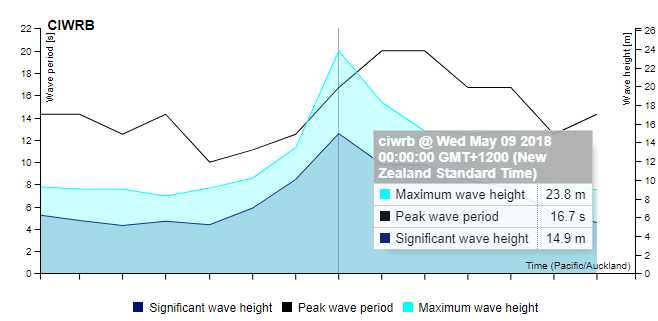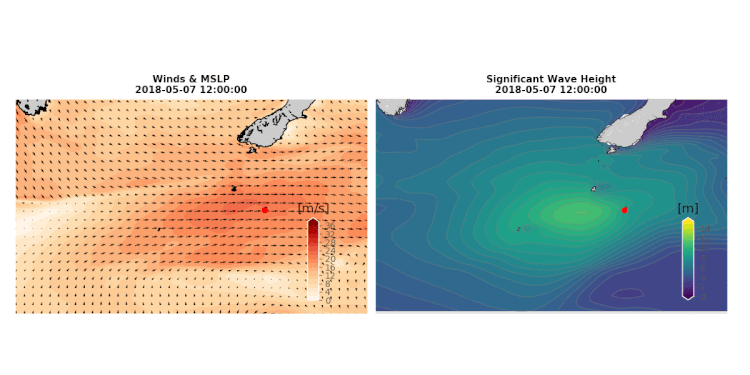source : Metocean NZ
Largest wave ever recorded in Souther Hemisphere reached 78 feet (23.8 m) on May 8.
Scientists believe waves in the Southern Ocean may have even reached 82 feet at one point,
but were unable to confirm this.
At 78 feet tall, and churned by a fierce storm, it’s the largest wave ever recorded in the southern hemisphere, New Zealand scientists report.
“This is a very exciting event and to our knowledge it is largest wave ever recorded in the southern hemisphere,” said Tom Durrant, a senior oceanographer with MetOcean Solutions, in a statement. “So, this is a very important storm to capture, and it will add greatly to our understanding of the wave physics under extreme conditions in the Southern Ocean.”
An enormous ocean wave reaching 78.1 feet (23.8 meters) in height has
just hit Campbell Island.
The previous record-breaking wave in this region was recorded in 2012
when a wave was found to have reached 72.3 feet (22.03 meters) in
height in Tasmania.
The intense storm
that has lashed the Southern Ocean around New Zealand and Campbell
Island will soon be giving surfing enthusiasts in California powerful
waves of their own.
Campbell island with the GeoGarage platform (Linz chart)The wave was recorded on the night of May 9 by a MetOcean buoy (Campbell island WRB (CIWRB) which is currently floating in the Southern Ocean near Campbell Island about 430 miles (692 km) south of New Zealand.
Campbell Island Wave Rider Buoy was moored on 2 March 2018 at Campbell Island
The wave reached a height of 78 feet (23.8 meters) as a storm rolled through the region.
The previous record, also recorded by MetOcean Solutions, was a 63.6-foot (19.4 meter) wave that rolled through the same patch of ocean last year.
Simulation of the storm : wind and Mean sea Level pressure (left) and significant wave height (right) passing over New Zealand
The wave was detected by a single solar powered buoy, which samples wave conditions for 20 minutes every three hours.
The intermittent sampling is done to conserve energy.
During the recording period, the height, period, and direction of each wave is measured, and the data is transmitted to a receiving satellite.
Oceanographers with MetOcean Solutions, a subsidiary of the state-owned Meteorological Service of New Zealand (MetService), believe the peak heights of waves were even higher during the storm. Their wave forecast predicted individual waves reaching heights of 82 feet (25 meters).
The Southern Ocean is one of the least-studied areas on Earth.
Its persistent and energetic winds make it an “engine room” for wave development, producing waves that traverse the globe, including the iconic surfing waves that reach the California coast.
The May 9 storm was generated by the easterly passage of a deep low-pressure system, and accompanied by winds reaching 65 knots (75 mph/120 km/h).
These low-pressure storms are typical in the Southern Ocean, and they can strike at any time of the year, unlike in the northern hemisphere where similar storms only happen in winter.
When measuring waves, oceanographers use a metric called “significant wave height.”
It’s a standard value that characterizes sea conditions, and it takes the average of the highest third of a measured wave.
The May 9 storm produced a significant wave height of 48.9 feet (14.9 meters), which is now a record for the Southern Ocean.
But it’s not the biggest ever recorded; that distinction goes to a 2013 North Atlantic wave with a significant wave height of 62 feet (19 meters).
According to the Smithsonian, the largest wave ever recorded was in Alaska’s Lituya Bay in 1958. It measured 30.5 meters (100 feet) and was caused due to a tsunami, which killed five people. The wave snapped 1,700 trees but did not damage much property as there were a very few towns nearby.
Links :
- BBC : Massive wave is southern hemisphere record, scientists believe
- SMH : Surf's really up: Largest wave ever recorded in Southern Ocean
- NZ Herald : Seven storeys high: Record monster wave in Southern Ocean
- GeoGarage blog : NZ tech could reveal planet's largest waves / 19-meter wave sets new record - highest significant ...




No comments:
Post a Comment